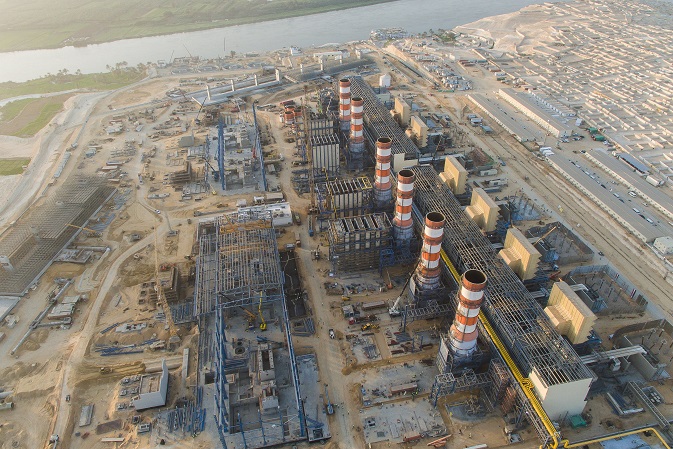
Together with its local Egyptian partners, Siemens is erecting three gas-fired combined cycle power plants, each with a capacity of 4.8 gigawatts, for a total combined capacity of 14.4 gigawatts.
German Chancellor Angela Merkel and Egyptian President Abdel Fattah El-Sisi symbolically inaugurated the first phase of SiemensвҖҳ megaproject in Egypt, marking an important milestone towards the completion of the project, the company said.
The plant will boost the countryвҖҷs power generation capacity by 45% when finished. Together with its local partners, Orascom Construction and Elsewedy Electric, Siemens said it broke records in modern power plant construction by connecting 4.8 GW of new capacity to the grid in only 18 months after the signing of the contract for the companyвҖҷs biggest single order ever.
Complementary to the megaproject, Siemens supports the development of future highly skilled Egyptian workforce, and has announced the details of a strategic alliance agreement between GermanyвҖҷs Federal Ministry for Economic Cooperation and Development (BMZ) and the company to support occupational training in Egypt. The announcement was made by Joe Kaeser, president and CEO of Siemens AG at an event, which was attended by local officials and business leaders.
The construction works for SiemensвҖҷ megaproject in Egypt are enormous. More than 1.6 million tons of material, including 960 000 tons of concrete and 48 000 tons of rebar steel, will be processed until completion. At Beni Suef, massive excavation works were necessary to prepare the site, leading to the removal of around 1.75 million m3 of rocks. This is equivalent to the volume of the smaller Giza pyramid, the company said. When completed, each of the three power plants, located at Beni Suef, New Capital and Burullus, is set to become the biggest gas-fired combined-cycle power station in the world. Altogether, the three power plants will have a combined capacity of 14.4 GW.
To increase the capacity of the transmission network nationwide, Siemens has successfully put the first three substations into operation that will transmit the electricity generated by the three power plants to EgyptвҖҷs power grid. The three substations, Etay El-Baroud, Maghagha and Kafr El Zayat, were ready for operation within ten months from signing the contracts, to match the implementation timeframe of the power plants. In December 2016, Siemens and El Sewedy Electric T&D, signed a contract with the Egyptian Electricity Transmission Company (EETC) for the design, engineering, supply and installation of six substations, located in the cities of Maghagha, Etay El-Baroud, Banha, Wadi El-Natroun, Assiut and Kafr El Zayat. The remaining substations will be completed and connected to the grid by the end of December 2017.
SiemensвҖҷ megaproject in Egypt also includes a nine-year service and maintenance agreements for the three power plants to help ensure the long-term reliability, availability and optimal performance of the units. The service and maintenance operations will be supported by Siemens digital services products and offerings, tapping into the companyвҖҷs advanced data analytics.
The financing package for the Siemens part of the contracts was structured by Siemens Financial Services (SFS). It also included a tailored guarantee concept. The financing of major parts of SiemensвҖҷ and its local partnersвҖҷ scope, for the three power plants, was provided by a consortium of international and regional banks. The credit facilities are largely covered by Export Credit Agencies.
As part of the agreement, Siemens will join forces with the Deutsche Gesellschaft fГјr Internationale Zusammenarbeit (GIZ) GmbH on behalf of BMZ, for the establishment and the operation of a joint training center as well as the strengthening of one selected Egyptian public vocational training institute. The program was designed in line with EgyptвҖҷs objectives outlined in вҖңEgypt Vision 2030вҖқ to promote long-term economic growth, create new jobs and increase the competitiveness of Egyptian industries.
вҖңIn addition to building a modern and efficient power infrastructure for the Egyptian people, Siemens is also supporting the training of a local workforce of more than 5,500 talented individuals in the next four years,вҖқ said Joe Kaeser. вҖңThis strategic partnership with GermanyвҖҷs Federal Ministry for Economic Cooperation and Development signifies a new milestone in SiemensвҖҷ history in Egypt, and underscores our joint commitment to support the countryвҖҷs long-term growth and development.вҖқ
Gerd MГјller, German Federal Minister for Economic Cooperation and Development: вҖңSustainable development needs private investment and a qualified workforce. Our close cooperation with Siemens will ensure that the new vocational training center takes the needs of the local job market into account. We want to provide the basis for further investment and more jobs in Egypt.вҖқ
Occupational training and the development of local skills are crucial to boosting local growth and increasing hiring prospects in the power industry and other sectors of the economy. For instance, in the energy sector alone, more than 20,000 workers and technicians are engaged at SiemensвҖҷ three power plant sites during implementation.

 Industry News
Industry News